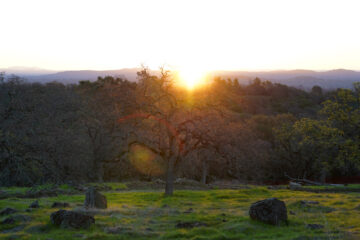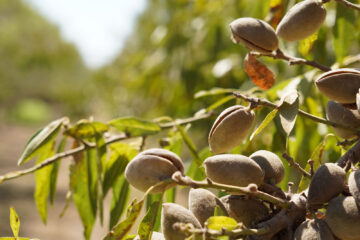Stream Restoration Funds Flow
By Jeff Darlington

Swainsons Grassland Preserve north of Lincoln contains a heavily impacted wetland and creek area that will be restored by PLT using U.S. Army Corps of Engineers’ mitigation funding.
Earlier this month, Placer Land Trust was pleased to receive word that the U.S. Army Corps of Engineers will award us with $500,000 for stream and wetland restoration!
The restoration project will take place on PLT’s 469-acre Swainsons Grassland Preserve in Lincoln, which contains diverse and intact vernal pool grassland and seasonal wetland habitat.
Prior to PLT acquiring the Preserve in 2005, a 15-acre section of the Preserve had been leveled and “checked” for irrigated pasture. This area had been heavily overgrazed, which caused degradation of the shallow creek that runs through the center of that parcel (a tributary to Coon Creek).
However, with receipt of the mitigation funding from the U.S. Army Corps of Engineers, PLT will be able to restore this area’s natural function.
The funding will restore 1,800 linear feet of riparian habitat, re-establish five acres of seasonal wetlands, and reseed/replant roughly 12 acres of grasslands.
PLT Land Manager Justin Wages will be working with Westervelt Ecological Services and other partners and volunteers to construct, maintain and monitor the restoration project.
Plantings will include several willow species, cottonwood, valley oak (from acorns procured from trees onsite) and native grasses. The creek will be fenced off to eliminate degradation caused by livestock. As a project enhancement, four Western burrowing owl artificial nesting systems will be installed in the adjacent grassland area.
The total acreage restored and protected will be 17 acres, with direct benefits to the property, habitat, water quality, and downstream water use.
From the Board Room
Bidding the Board a Fond Farewell
by Patrica Callan-McKinney
While I was working, I wasn’t able to participate actively in a conservation organization, but I felt I was doing my part by sending a check and educating myself. My favorite organization was The Nature Conservancy. It made sense to me that in order to save any animal or plant, you had to permanently preserve habitat. I vowed that when I retired, I would go off to the jungle, sit in a tree and count birds and then get involved in something local.
Well, I retired and went off to Baja to count turtles (close), and wha-daya-know! There was an article in the paper that Placer Land Trust was looking for volunteers and Board members.
It made sense to me that in order to save any animal or plant, you had to permanently preserve habitat.
I joined Placer Land Trust & Nature Center in February 1997 as a Board member, and I found that all the energy and resources went to the Nature Center and nothing was happening in the land trust part. Somehow I became President. My interest was in promoting the land trust, so off I’d go to farmers’ markets and fairs with my card table, a chair, brochures and a hand made sign and most likely raffle tickets.
I discovered no one knew what a land trust was, and I spent a lot of time explaining to some pretty hostile people that a land trust is not a bank and doesn’t confiscate land. I took over editing the newsletter and kept track of members. During this time the Trust was able to raise some money, and I wrote our first conservation easement.
The major turning point for the Trust came from two generous donations and a grant which allowed us to hire an Executive Director, and – with the help of a consultant – split the organization into two separate nonprofits. The Nature Center has continued to educate children throughout the area.
In the time around 2000-2003, my husband was ill and I was caring for my 97-year old mother, so I had to back off and turned the presidency over to Bob Gilliom.
It wasn’t long before I agreed to be Treasurer when no one else would do it. This was literally a kitchen table operation. Money in – money out, and there wasn’t much of it. I kept careful track of the few dedicated funds (God bless QuickBooks). I did the banking and paid the bills. Since I am a pennypinching, need-to-know-where-everypenny-is kind of person, I enjoyed this job. As the Trust grew, and the books became more detailed and complicated, it was necessary to comply with rigorous general accounting standards. Ask Assistant Director Jessica Pierce about the hours we spent categorizing and numbering the accounts. Now, of course, the Trust has a CPA who keeps the books. I retired as Treasurer at the end of 2010.
I chaired three fund-raising events. That was the most fun for me. I love parties, and I met so many incredible people at Placer Land Trust events – especially among the agricultural community.
It has been my pleasure and privilege to be among those who have served on this Board. From the beginning, this has been a hands-on, very involved group.
When I began, the Trust owned 26 acres on the American River and had about $6,000 in the bank. Today, Placer Land Trust has protected 7,171 acres and has millions in stewardship endowments.
Naturally the work has shifted from the volunteer Board to a very committed, competent, young, paid staff. I am so proud of them. Placer Land Trust is in good hands.
These past 14 years have been a very special time in my life, and I am satisfied that I have contributed to the success of Placer Land Trust.
My passion for land preservation is still strong, but it’s time for me to move on and to get my “hands on” a new endeavor.
State Insect Shows its “face” at Shutamul
by Erin Tarr
In 1929, California chose the California dogface butterfly (Zerene eurydice) as the official state insect. This butterfly has a range from San Diego County to Sonoma County and is usually found in mountain and foothill locations. Its host plant is false indigo (Amorpha californica), which adults use as a nectar source and a place to lay eggs and caterpillars use as a food source.
Tipped off by a recorded sighting of the plant catalogued by the California Native Plant Society, local naturalist/birdwatcher and practicing amateur lepidopterist Deren Ross found false indigo at Placer Land Trust’s Shutamul Bear River Preserve in 2008.
Ross visited Shutamul annually for the next two years documenting many dogface butterflies. He later learned from Professor Art Shapiro at UC Davis that the life history was not well understood especially for over-wintering adults. Ross seized this opportunity to conduct a scientific study documenting the dogface life-cycle.
Ross has visited Shutamul weekly this summer with PLT Stewardship Assistant Erin Tarr to conduct male/female butterfly counts and observe behavior patterns. This exciting study has recorded many facets of the dogface lifecycle; they’ve observed eggs being laid on the false indigo … and now the caterpillars are busy munching away at the plant.
Ross plans to continue collecting data at Shutamul in the months and years to come adding to the scientific community’s understanding of the state insect.
Stewardship Report – Habitat Enhancement & More
By Jeff Ward
Placer Land Trust continues to work hard to enhance the properties we’ve protected, and we anticipate being very busy this fall with numerous projects, ranging from native plant and habitat restoration to trail building.
In addition to the riparian restoration project at Swainsons Grassland Preserve, there are three major enhancement projects on tap for this fall.
Habitat restoration will take place on Doty Ravine Preserve in Lincoln. Restoration efforts will include removing invasive plants and planting native trees, shrubs and flowers. We will have two Eagle Scouts candidates working on the project as well as youth from the Sierra Native Alliance. The outcome will be enhancements to wetland, riparian, and grassland habitat on approximately 92 acres of the Preserve.
Last year PLT completed an initial phase of our Canyon View Preserve Restoration Project, utilizing funding from the Sierra Nevada Conservancy. We were able to complete streambed enhancement and stabilization in the lower section of Sierra Canyon Creek to reduce erosion and sedimentation in the creek and in the North Fork American River. We also completed two shaded fuel breaks on the Preserve to reduce fire hazard.
This fall, we plan to begin construction of the Phase 2 of the Canyon View Riparian Habitat and Trail Project funded by the California Resources Agency through the Proposition 84 River Parkways funding. This will include construction of a 1.5-mile interpretive trail on the Preserve that will showcase the restoration project and provide education about the American River watershed. We’ll also work with volunteers to plant native trees, shrubs, and flowering plants along the new trail in an effort to re-establish food sources and host plants for native pollinators (like butterflies) and numerous bird species. We’re also in the process of planning and designing additional stream stabilization and enhancement in the upper reach of Sierra Canyon Creek, with construction to begin in spring 2012.
PLT is also ramping up efforts to provide public access on some of our Preserves. For example, we’re building a small neighborhood trail through a section of the Stagecoach Preserve in Auburn this fall. We’ll work with volunteers to clear and construct a trail corridor through a section of the Preserve that runs from Foresthill Avenue to Russell Road.
PLT will be seeking volunteers to help with many of these enhancement projects, including the pollinator trail plantings, invasive plant management and trail building. If you are interested in volunteering with Placer Land Trust, please contact us at (530) 887-9222.
Great Sierra River Cleanup
PLT Hosting Two Locations on Sept. 17th
Join PLT to clean up two streams in the American River watershed as part of the third annual Great Sierra River Cleanup, September 17!
During the first two years of the Great Sierra River Cleanup more than 7,500 volunteers have joined together to remove over 270 tons of trash and recyclables from Sierra streams that supply the State of California with 65 percent of its water.
This effort, led by the Sierra Nevada Conservancy, promotes good stewardship on all of our waterways, from the source to the sea.
For more details, contact PLT Outreach Assistant Becki Hoehn.





